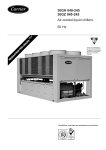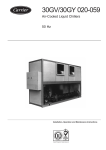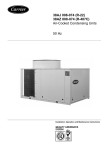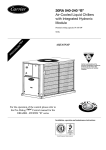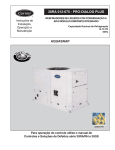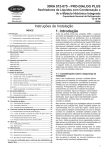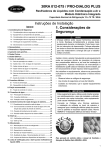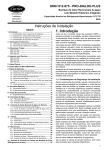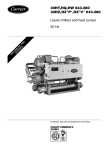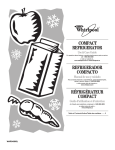Download Carrier 30 GA Technical data
Transcript
30GH/GZ 009-035 Air-Cooled Liquid Chillers 50 Hz Installation, Operation and Maintenance Instructions 1 CONTENTS Page Start-up checklist .......................................................................................................................................................................... 3 Dimensions/clearances (standard unit) ....................................................................................................................................... 4 Dimensions/clearances (unit with optional Hydroflow kit) ...................................................................................................... 6 Physical/electrical data ................................................................................................................................................................. 8 Application data (standard unit) ............................................................................................................................................... 10 Minimum evaporator water flow rates ......................................................................................................................................... 10 Maximum evaporator chilled water flow rates ............................................................................................................................. 10 Water loop volume ....................................................................................................................................................................... 10 Application data (unit with optional Hydroflow kit) .............................................................................................................. 11 Water flow rates ........................................................................................................................................................................... 11 Available static pressure ............................................................................................................................................................... 11 Water loop volume ....................................................................................................................................................................... 12 Installation ................................................................................................................................................................................... 13 Safety considerations .................................................................................................................................................................... 13 Preliminary checks ....................................................................................................................................................................... 13 Moving and siting the unit ............................................................................................................................................................ 13 Water connections ...................................................................................................................................................................... 14 Optional Hydroflow kit ................................................................................................................................................................ 15 Power supply ............................................................................................................................................................................... 15 Electrical checks ........................................................................................................................................................................... 15 Start-up ........................................................................................................................................................................................ 15 Preliminary checks ....................................................................................................................................................................... 15 Actual start-up .............................................................................................................................................................................. 16 Electromechanical control ............................................................................................................................................................ 16 PRO-DIALOG control ................................................................................................................................................................. 16 Servicing refrigeration components .......................................................................................................................................... 17 General maintenance .................................................................................................................................................................... 17 Liquid refrigerant charging ........................................................................................................................................................... 17 Compressors ................................................................................................................................................................................. 18 Heat exchangers ............................................................................................................................................................................ 19 Condenser coil .............................................................................................................................................................................. 19 Fan motor replacement ................................................................................................................................................................. 20 Fan motor protection .................................................................................................................................................................... 20 Refrigerant circuit ......................................................................................................................................................................... 20 Pressure switch settings ................................................................................................................................................................ 20 Troubleshooting chart ................................................................................................................................................................ 21 The photo shown on the front cover is solely for information, and not contractually binding. The manufacturer reserves the right to make changes without previous notification. 2 START-UP CHECK LIST Start-up date: Equipment sold by: Contract No.: Installed by: Contract No.: Site address: Start-up date: Equipment type and serial number: 30GH/GZ Electrical data: Supply voltage: Ph. Nominal voltage: V Current draw: Ph. 1 V Ph. 2 V Ph. 3 V A Ph. 3 A % network voltage: Control circuit voltage A Ph. 2 V Circuit breaker rating Main circuit breaker rating: A A Technical data: Condenser: Cooler: Entering air temperature: °C Entering water temperarture: °C Leaving air temperature: °C Leaving water temperature: °C Pressure drop (air): kPa Discharge air pressure: Pressure drop (water): kPa Pa Fan speed: r/s or rpm Fan motor current: Ph. 1 A Ph. 2 A Ph. 3 A Ph. 1 A Ph. 2 A Ph. 3 A Safety device setting: High pressure switch: cut-out kPa: cut-in kPa Low-pressure switch: cut-out kPa cut-in kPa Safety thermostat: cut-out °C cut-in °C Control thermostat: cut-out first step °C cut-in first step °C cut-out second step °C cut-in second step °C Oil level: Oil visible in sight glass: Colour of moisture indicator: Air bubbles visible in sight glass: Accessories: Commissioning engineer (name): Customer agreement Name: Date: Remarks: NOTE: Please fill in this sheet during the installation 3 Dimensions and clearances (standard unit) 30GH/GZ A B C D E F G 009-013 015-025 030-035 1160 1720 2060 1220 1160 1370 1060 1112 1231 1200 1200 1200 1000 1000 1000 1000 1000 1000 1000 1000 1200 Legend: All dimensions are given in mm. Required service clearance 30GH and 30GZ 009-013 Do not obstruct Power supply Water inlet Water outlet Note: Certified drawings are available on request. 30GH and 30GZ 015-025 Do not obstruct 4 30GH and 30GZ 030-035 Do not obstruct Floor mounting • • For unit mounting holes, weight distribution and centre of gravity coordinates, refer to the dimensional drawings. These units are designed for outdoor installation. CAUTION: • • • Ensure the air flow around the unit is not obstructed. If several units are installed, next to each other, ensure that the space in between the units is the same as the unit depth. There must not be any roof or cover above the unit. 5 Dimensions and clearances (unit with optional Hydroflow kit) CAUTION: ONLY PRO-DIALOG UNITS CAN BE EQUIPPED WITH THE OPTIONAL HYDROFLOW KIT. 30GH/GZ A B C D E F G 009-013 015-025 030-035 1160 1720 2150 1310 1246 1370 1781 1833 2052 1200 1200 1200 1000 1000 1000 1000 1000 1000 1000 1000 1200 Legend: Required service clearance All dimensions are given in mm. Power supply Water inlet Water outlet 30GH and 30GZ 009-013 Note: Certified drawings are available on request. 30GH and 30GZ 015-025 6 30GH and 30GZ 030-035 Floor mounting • • For unit mounting holes, weight distribution and centre of gravity coordinates, refer to the dimensional drawings. These units are designed for outdoor installation. CAUTION: • • • Ensure the air flow around the unit is not obstructed. If several units are installed, next to each other, ensure that the space in between the units is the same as the unit depth. There must not be any roof or cover above the unit. 7 Physical data Size 009 013 015 020 025 030 035 31.6 32.0 40.1 41.0 52.0 53.0 64.0 65.0 74.0 75.0 93.0 94.0 Net nominal cooling capacity 30GH* Net nominal cooling capacity 30GZ* kW kW 21.2 21.0 Operating weight kg 265 283 400 460 510 682 725 Refrigerant charge (R-22 - 30GH) Refrigerant charge (R-407C - 30GZ) kg kg 6.5 7.5 8.0 9.0 9.2 10.5 11.9 13.5 13.3 15.0 15.7 15.7 16.5 18.6 % 1 ... hermetic, 48.3 r/s 1 ... semi-hermetic, 4 or 6 cylinders, 24.2 r/s PRO-DIALOG or electromechanical 1 1 2 2 2 100 100 66 50 66 2 66 2 66 Compressor Control type Capacity control steps Minimum capacity step Evaporator Water volume No. of refrigerant circuits Water conncetions Inlet/outlet Max. water side operating pressure kPa Direct-expansion, plate heat exchanger 1.9 2.8 3.8 1 1 1 Gas thread 1-1/2 1-1/2 1-1/2 1000 1000 1000 Condenser Fans Quantity Total air flow Fan speed** l/s r/s Copper tube, aluminium fins Propeller 1 1 2640 2640 15.8/12.5 15.8/12.5 Low-noise shrouded axial Flying Bird fan 1 1 1 4700 4700 4700 12.5 12.5 12.5 2 9400 12.5 2 9400 12.5 OPTIONAL HYDROFLOW KIT Nominal water flow rate Available pressure Unit operating weight Buffer tank capacity l/s kPa kg l 1 70 297 100 1.5 36 616 100 3.0 72 854 150 2.5 62 915 150 3.1 45 966 150 3.6 60 1369 300 4.5 59 1413 300 l l 8 112 18 113 18 174 18 175 18 176 24 337 24 338 in in 1-1/2 1-1/4 1-1/2 1-1/4 1-1/2 1-1/2 1-1/2 1-1/2 1-1/2 1-1/2 1-1/2 2-1/2 1-1/2 2-1/2 Expansion tank capacity Water volume Water connections Inlet Outlet l in 4.7 1 5.6 1 6.6 1 7.5 1 1-1/2 1000 1-1/2 1000 1-1/2 1000 1-1/2 1000 * Net cooling capacity = gross cooling capacity minus the water pump heat against the internal evaporator pressure drop. Evaporator entering/leaving water temperature 12°C and 7°C. Condenser entering air temperature 35°C. ** The first figure is for the standard fan, the second figure is for the optional low speed fan. Electrical data Size 009 013 015 020 025 030 035 Power supply Nominal power supply Voltage range V-ph-Hz V 400-3-50 360-440 Auxiliary circuit Auxiliary circuit power input (heaters) V-ph-Hz W 230-1-50 70 70 110 250 250 250 250 Fan power input Fan power supply kW V-ph-Hz 0.80 400-3-50 0.80 1.15 1.15 1.15 2.30 2.30 Nominal unit power input* Maximum unit power input** Maximum unit starting current Nominal unit current drawn* Maximum unit current drawn** kW kW A A A 8.4 10.0 83.2 13.2 24.7 13.7 16.8 136.7 22.5 38.7 13.6 16.4 87.0 21.1 34.0 18.2 22.0 107.0 29.0 38.9 24.2 29.0 134.0 39.3 51.0 26.9 32.3 158.0 42.1 60.0 37.8 46.2 213.0 60.7 83.0 UNIT WITH OPTIONAL HYDRAULIC KIT Nominal unit power input* kW Maximum unit power input** kW Maximum unit starting current A Nominal unit current drawn* A Maximum unit current drawn** A Heater power input W 8.9 10.6 84.5 14.4 26.0 120 14.2 17.4 138.0 23.7 40.0 120 14.3 17.2 88.7 27.7 35.7 150 18.9 22.8 108.7 30.6 40.6 150 24.9 29.8 135.7 40.9 52.7 150 28.3 33.8 161.0 45.0 62.9 220 39.2 47.7 216.0 63.6 85.9 220 * Evaporator entering/leaving water temperature 12°C and 7°C. Condenser entering air temperature 35°C. ** Evaporator entering/leaving water temperature 18°C and 13°C. Condenser entering air temperature 45°C. Currents are given at nominal voltage. 8 NOTES: • 30GH/GZ 009-035 units have a single power connection point. • A separate power source (230 V, 1 ph, 50 Hz) that does not exceed the main switch capacity is required to power the compressor crankcase heater circuit. This source must be supplied from a transformer. It must not be supplied from a phase + neutral supply (for ground + neutral systems). • The control box includes the following standard features: Starter and motor protection devices for each compressor and the fan(s) Control devices • Field connections: All connections to the system and the electrical installations must be in full accordance with all applicable codes. • The Carrier 30GH/GZ 009-035 chillers are designed and built to ensure conformance with local codes. The recommendations of European standard EN 60 204-1 (machine safety - electrical machine components - part 1: general regulations) are specifically taken into account, when designing the electrical equipment. • Conformance with EN 60 204 is the best means of ensuring compliance with the Machines Directive and §1.5.1. Generally the recommendations of IEC 364 are accepted as compliance with the requirements of the installation directives. • Annex B of EN 60204-1 describes the electrical characteristics used for the operation of the machines. 1. • • The operating environment for the 30GH/GZ 009-035 chillers is specified below: Environment* - Environment as classified in IEC 60 721: - outdoor installation* - ambient temperature range: -18°C to +46°C, class 4K4H* - altitude: ≤ 2000 m* - presence of hard solids, class 4S2 (no significant dust present) - presence of corrosive and polluting substances, class 4C2 (negligible) - vibration and shock, class 4M2 Competence of personnel, class BA4* (trained personnel IEC 364) * The protection level required to conform to this class is IP43BW (according to reference document IEC 529). All 30GH/GZ 009-035 units are protected to IP44CW and fulfill this protection condition. 2. 3. 4. 5. Power supply frequency variation: ± 2 Hz. The neutral (N) line must not be connected directly to the unit (if necessary use a transformer). Overcurrent protection of the power supply conductors is not provided with the unit. The factory-installed circuit breaker is of type “a” (EN 60 204-1 § 5.3.2). NOTE: If particular aspects of an actual installation do not conform to the conditions described above, or if there are other conditions which should be considered, always contact your local Carrier representative. 9 APPLICATION DATA (STANDARD UNIT) NOTE: The compressor must not restart more than 10 times in an hour. Minimum evaporator water flow rates Min. flow rate, l/s 009 013 015 020 025 030 035 0.3 0.5 0.7 0.8 1.0 1.2 1.3 STANDARD 30GH 30GH WITH LOW TEMPERATURE OPTION 50 45 OUTDOOR AIR TEMPERATURE, °C 30GH/GZ 30GH Operating range If the flow rate is lower, follow the recommendations below: a. It is possible to install several chillers of lower capacity in series, each one supplying a part of the ∆T. b. The water from the evaporator can be recirculated, in order to increase the flow rate. The temperature of the mixed water entering the evaporator must be at least 2.8 K higher than the leaving water temperature. Maximum evaporator chilled water flow rate 40 40 30 33 20 12 10 30GH 009-025 0 30GH 030-035 01 -10 -5 * * WATER 0 5 10 15 EVAPORATOR LEAVING WATER TEMPERATURE, °C * Application down to -18°C with head pressure control option Note: Evaporator ∆t = 5 K 30GZ Operating range 30GZ with glycol option CONDENSER ENTERING AIR TEMPERATURE, °C 2.2 3.2 4.0 5.3 6.5 7.3 9.2 The minimum temperature difference is 2.8 K which corresponds to a water flow rate of 0,9 l/s per kW. Water loop volume 13 GLYCOL Max. flow rate, l/s 009 013 015 020 025 030 035 30GH 009 30GH 013 30GH 025 43 36 This is limited by the maximum permitted evaporator pressure drop. 30GH/GZ 45 42 50 45 43 40 42 40 39 39 30GZ009-025 30 20 10 30GZ009-013 12 0 GLYCOL -10 -5 0 WATER 5 10 15 EVAPORATOR LEAVING WATER TEMPERATURE, °C * Application down to -18°C with head pressure control option Note: Evaporator ∆t = 5 K Whatever the size of the system, the water loop minimum volume is given by the following formula: Evaporator pressure drop curve 100 90 80 70 60 Volume = CAP (kW) x N* = litres where CAP is the nominal system capacity (kW) at the nominal operating conditions of the installation. 50 40 30 It is often necessary to add a storage tank to the circuit in order to achieve the required volume. The tank must itself be internally baffled in order to ensure proper mixing of the liquid (water or brine). Refer to the examples below. 05 5 4 /G Z 30 013 GH /G Z 30 GH 015 /G 30 Z0 GH 20 30 / GH GZ 0 /G 25 Z 30 03 GH 0 /G Z0 35 10 9 8 7 6 GH This volume is necessary for stable operation and accurate temperature control. 20 GH /G Z0 3.25 6.5 10.8 30 Air conditioning Industrial process cooling Low temperature operation 30 N* Pressure drop, kPa Application 3 2 1 0.9 0.8 0.7 0.6 0.5 0.4 0.3 Bad Good 0.2 0.1 0.1 0.2 0.3 0.4 0.5 1 Water flow rate, l/s Bad 10 Good 2 3 4 5 6 7 8 9 10 APPLICATION DATA (UNIT WITH OPTIONAL HYDRONIC KIT) Water flow rate 30GH/30GZ HYDROFLOW module option Maximum flow rate* Minimum flow rate l/s l/s 009 013 015 020 025 030 035 1.6 0.3 1.7 0.5 3.0 0.7 3.3 0.8 3.3 1.0 4.6 1.2 5.7 1.3 * Maximum water flow rate for an available static system pressure of zero. Available static pressure Available static pressure for a single pump kPa m WG 200 20 180 18 160 16 140 14 120 12 100 10 80 8 60 6 40 4 20 2 0 0 1 1 30GH/GZ 009-013 2 30GH/GZ 015-025 3 2 3 30GH/GZ 030-035 2 3 4 6 5 7 8 9 10 20 15 30 40 50 60 70 80 m3/h. I/s. 0,5 1,5 1 2,5 3,5 10 7 5 15 20 Available static pressure for a dual pump kPa 1 30GH/GZ 009-013 2 30GH/GZ 015-025 3 30GH/GZ 030-035 m WG 200 20 180 18 160 16 140 14 120 12 100 10 80 8 60 6 40 4 20 2 0 0 1 3 2 2 3 4 5 6 4 6 8 10 12 7 8 9 10 15 20 30 40 14 16 18 20 30 40 60 80 50 60 70 80 Qm3/h. Qm3/h. two pumps in paralle 100 120 140 160 I/s. 0,5 kPa m WG 150 15 140 14 130 13 120 12 110 11 100 10 90 9 80 8 70 7 60 6 50 5 40 4 30 3 20 2 10 1 0 0 1 1,5 2,5 3,5 5 7 10 15 20 Available static pressure for HYDROFLOW units (30GH/GZ 009-013) 01 3 00 9 1 2 3 4 5 6 7 0,28 0,55 0,83 1,11 1,39 1,67 1,94 m3/h. I/s. 11 Available static pressure for HYDROFLOW units (30GH/GZ 015-025) kPa m WG 150 15 140 14 130 13 120 12 110 11 100 10 90 9 8 70 7 60 6 50 5 3 20 2 10 1 0 0 020 4 30 5 02 40 5 01 80 5 10 15 1,39 2,78 4,17 20 m3/h. I/s. 5,56 Available static pressure for HYDROFLOW units (30GH/GZ 030, 035) kPa m WG 150 15 140 14 130 13 120 12 110 11 100 10 90 9 7 60 6 50 5 3 20 2 10 1 0 0 ` 5 4 30 0 40 03 8 70 03 80 5 10 15 20 1,39 2,78 4,17 5,56 25 m3/h. I/s. • • • 12 The water circulating pumps in the HYDROFLOW module are sized to cover the widest application range. For this reason it is essential to install a water flow controller in the hydraulic circuit to maintain the water flow at the desired flow rate. With the pressure loss generated by the water flow controller in the water circuit, the controller must be able to impose the system pressure/ flow curve on the pump pressure/flow curve, to obtain the desired operating point. The pressure gauge installed on the pump, together with the isolating valves upstream and downstream, allows the pressures upstream and downstream of the pump to be read. Using the total pressure difference read, the water flow rate for the installation is taken from the pressure/flow curve for the pump alone. This flow rate is adjusted with the flow controller and reading the flow rate from the corresponding curves. 6,95 If the water circuit has a pressure drop that is higher than the pressure available from the HYDROFLOW unit, the water flow rate will be reduced, and the difference between the HYDROFLOW module water entering and leaving temperatures will increase. To reduce the pressure drop in the hydraulic circuit: • minimize the individual pressure drops in number and size (elbows, bends, accessories). • use correctly sized piping. • avoid extensions and branches in the water circuit as much as possible Water loop volume The unit includes an integrated buffer tank. A supplementary buffer tank should be installed, if the built-in buffer tank does not supply sufficient capacity (see chapter Water loop volume under Application Data for the standard unit on page 11. INSTALLATION SAFETY CONSIDERATIONS Installation, start-up and servicing this equipment can be hazardous due to system pressures, electrical components and equipment location (roofs, elevated structures, etc.). Only trained, qualified installers and service mechanics should install, start-up and service this equipment. Untrained personnel can perform basic functions, such as cleaning coils. All other operations should be performed by trained service personnel. CAUTION: Before lifting the unit, check that all casing panels are securely fixed in place. Lift and set down the unit with great care. Tilting and jarring can damage the unit and impair unit operation. The units can be hoisted with rigging or lifted by forklift. Coils should always be protected against crushing while a unit is being moved. Use struts or spreader bars to spread the slings above the unit. Do not tilt a unit more than 15°. WARNING: Never push or lever on any of the enclosure panels of the unit. Only the base of the unit frame is designed to withstand such stresses. When working on the equipment, observe precautions in the literature, and on tags, stickers, and labels attached to the equipment. • • • Follow all safety codes. Wear safety glasses and work gloves. Use care in handling, rigging and setting down bulky equipment. WARNING: Before doing any work ensure that the power supply (400 V and 230 V) is disconnected, and switches and isolators are opened and tagged. During operation some parts of the unit reach or exceed temperatures of 70°C (e.g. compressor discharge side, discharge line). Only trained and qualified engineers, aware of these hot surfaces, are allowed to perform maintenance operations. Preliminary checks Check equipment received • Inspect the unit for damage or missing parts. If damage is detected, or if shipment is incomplete, immediately file a claim with the shipping company. • Confirm that the unit received is the one ordered. Compare the nameplate data with the order. • Confirm that all accessories ordered for on-site installation have been delivered, and are complete and undamaged. Moving and siting the unit Location for installation • • • • • • The permitted loading at the site must be adequate or appropriate strenghtening measures must be taken. The surface must be horizontal, flat and intact. There must be adequate space around the unit to make power and water connections and for service and air flow. There must be adequate support points and they must be in the right places. The location must not be subject to flooding. Where heavy snowfall is likely and long periods of subzero temperatures are normal, provision has been made to prevent snow accumulating by raising the unit above the height of drifts normally experienced. Baffles may be necessary to deflect strong winds and to prevent snow from blowing directly into the unit. They must not restrict air flow into the unit. 13 Water connections Water-loop connections Make the water-side heat exchanger connections, using appropriate hardware capable of ensuring water-tightness of the threaded unions. Refer to the certified dimensional drawings for the sizes and positions of all water inlet and outlet connections. The water pipes must not transmit any radial or axial force to the heat exchangers or any vibration to the pipework or building. Allowable load (Nm) for brazed plate heat exchangers The water supply must be analysed and appropriate filtering, treatment, control devices, isolation and bleed valves and circuits built in, as necessary. Consult either a water treatment specialist or appropriate literature on the subject. Operating precautions The water circuit should be designed to have the least number of elbows and horizontal pipe runs at different levels. Below the basic checks to be done (see also the illustration of a typical hydraulic circuit below). • • • • • • • • • • • Note the water inlets and outlets of the heat exchangers. Install manual or automatic air purge valves at all high points in the water circuit. Use an expansion chamber or an expansion/relief valve to maintain pressure in the system. Install water thermometers in both the entering and leaving water connections close to the evaporator. Install drain valves at all low points to allow the whole circuit to be drained. Install stop valves, close to the evaporator, in the entering and leaving water lines. Use flexible connections to reduce the transmission of vibration to the pipework. Insulate all pipework, after testing for leaks, both to reduce thermal leaks and to prevent condensation. Cover the insulation with a vapour barrier. A flow switch should be installed on a straight, horizontal stretch of piping, with a minimum length of five times the line diameter both before and after it. Where there are particles in the fluid that could block the heat exchanger, strainers should be used. Particles up to 1 mm in diameter will not cause any probblems. These correspond to a mesh size of 16-20 (depending on the diameter of the wire used). Bending Twisting Assembly conditions 1** Assembly conditions 2* 160 350 100 200 * Assembly load in cold conditions ** Loads due to piping forces during normal operation The illustration below shows a typical hydraulic circuit. IMPORTANT: In winter frost can cause cooler damage. Use appropriate methods of protection, according to the climatic conditions: • Add ethylene glycol. • Increase the insulation thickness. • Do not de-energize the cooler and the hydraulic circuit heaters. • For a prolonged shutdown period, drain the water from the cooler and replace it with ethylene glycol. At the beginning of the next cooling season, refill the cooler and add the recommended inhibitor. Auxiliary equipment should be installed according to basic refrigeration and piping practices, especially with respect to minimum and maximum cooler water flow rates, which must be between the values given in the tables in the 'Application data' section. NOTE: We strongly recommend the installation of the strainers. Typical hydraulic circuit diagram AIR VENT CONTROL VALVE FLOW SWITCH FLEXIBLE CONNECTION HEAT EXCHANGER BUFFER TANK FILL VALVE EXPANSION TANK 14 Pressure tap FILTER DRAIN Thermostat sleeve Hydraulic diagram Power supply The power supply must conform to the specification on the chiller nameplate. The supply voltage must be within the range specified in the electrical data table. For connections refer to the wiring diagrams. WARNING: Operation of the chiller with an improper supply voltage or with excessive phase imbalance constitutes abuse which will invalidate the Carrier warranty. If the phase imbalance exceeds 2% for voltage, contact your local electricity supply company at once and ensure that the chiller is not switched on until corrective measures have been taken. Voltage phase imbalance (%) : = 100 x max.deviation from average voltage deviation Average voltage Electrical checks 1 2 3 4 5 6 7 8 9 10 11 12/13 14 Evaporator Water flow switch Buffer tank Manual drain valve Manual air vent valve Expansion tank Pressure gauge Safety valve Isolating valve Filter Pump Isolating valves (pressure check upstream/downstream of the pump) Pressure gauge WARNING: Never switch off the power supply to the crankcase heaters unless the chiller is out of service for a seasonal shutdown or lengthy repair. The heaters must be re-energised for at least 24 hours before the chiller is restarted. 1. 2. 3. 4. 5. IMPORTANT: The flow controller prevents any unit start-up if the flow rate is not sufficient. Its changeover point is controlled and calibrated at the factory. Hydraulic connections Please refer to the previous chapter. Install purge valves and drain valves for the unit and the system (a drain valve is provided in the lower part of the buffer tank with a quarter turn globe valve). Purge valves must be installed at all high points of the system, with a drain valve at the lowest point. The standard filter can be backed up by a supplementary filter in the external circuit, if the mesh or filter is inadequate. IMPORTANT: The defrost function, using an electric trace heater, has continued power supply to the heater, if the pump is switched off. This allows keeping the HYDROFLOW module frost-free down to an outdoor air temperature of -12°C. Outside drains and pipes for the HYDROFLOW module are recommended, if the unit is not used at temperatures below 0°C. It is recommended to protect the chilled water pipes that are exposed to low ambient temperatures by a strip heater and by wrapping them with closed-cell insulation material of 19 mm thickness. Switch the unit off. Open the control circuit disconnect switch. Check the transformer connections. Ensure that the control circuit corresponds to the wiring diagram for the unit. Check that all electrical connections are secure at the terminals, contactors, bus bars and compressor terminal blocks. Start-up Preliminary checks • Never be tempted to start the chiller without reading fully, and understanding, the operating instructions and without having carried out the following pre-start checks : • Confirm that all crankcase heaters are working by feeling all compressor crankcases. Every compressor has a cartridge heater (see the wiring diagram). The heater remains energised even when the chiller is shut down to stop the lubricating oil from absorbing refrigerant. • Check the operation of all accessories - chilled water circulating pumps, air handlers and other equipment connected to the evaporator. Follow the individual manufacturer's instructions for this equipment. • It is recommended to connect the auxiliary contact of the water pump contactor to ensure maximum unit safety (see wiring diagram delivered with the unit). • Fill the chilled water circuit with clean water, and an inhibitor formulated specifically for this purpose, or fill it with another non-corrosive fluid to be chilled. • Purge air at all high points in the system. If water temperatures below 4°C (30GH) or 5°C (30GZ) are likely, add the appropriate volume of ethylene glycol to prevent freezing. • Confirm that the suction and discharge line stop valves are fully opened. • Open the refrigerant line valves. Check again that the water circuit valves are open. 15 • • • • • Check that oil is visible in each compressor sight glass to between 1/8 and 3/8 of the total glass depth (check for all compressors). Confirm that there are no refrigerant leaks. Confirm that the installation is correct and check the secure positioning of all control sensors. Confirm that discharge muffler securing bands and discharge line connections are tight. Check that all electrical connections are secure. Design set point adjustment (three-step thermostat) TEMPERATURE DROP TEMPERATURE RISE F 0 RY3 RB3 RY3 RB3 F 0 0 F RY2 RB2 RY1 RB1 F 0 0 F A RY2 RB2 RY1 RB1 B 0 F SET POINT Checks before start-up at the optional hydronic kit IMPORTANT: • The safety valve installed in the Hydroflow module is activated at 370 kPa, during charging. Please ensure that this pressure is not exceeded. • The nitrogen pressure of the expansion tank is controlled to 100 kPa above the static pressure of the installation. • Using the pump pressure gauge and the curves for the available static pressure of the pump, verify the water flow for the installation. Actual start-up IMPORTANT: • Commissioning and start-up of the chiller must be supervised by a qualified refrigeration engineer. • Start-up and operating tests must be carried out with a thermal load applied and water circulating in the evaporator. • All set point adjustments and control tests must be carried out before the unit is started up. • Please refer to the controls manual for the unit. Electromechanical control Multi-step thermostat This consists of a series of load switches actuated by the pressure developed inside a temperature sensing bulb, installed in the cooler inlet. Legend: A B R, Y, B O F - Differential between stages Differential on one contact Thermostat contact reference Open contact Closed contact Set point adjustment When the unit is ready for operation, insert a small screwdriver in the adjusting slot to turn the dial (the dial may also be turned by hand). Rotate the screwdriver, until the design set point for the installation appears directly under the pointer. Insert a thermometer in the return water connection and allow the unit to run through a complete cycle. When switch No. 1 opens, the last capacity step appears directly under the pointer. Read the temperature. If it is not the same as the dial reading, it can be compensated by shifting the control point slightly. NOTE: Do not force the dial past the stop. This could cause loss of the control point and damage the instrument. Set point adjustment POINTER ADJUSTING SLOT Before replacing the bulb, half fill the well with a heat conducting sealing compound. Replace the sensor in the well recess. The thermostat is factory-set to control from the return water temperature through a cooling range of 5.6 K. The sequence switches are factory-calibrated and sealed and should not need any field calibration. One step on sizes 009-013, two steps on sizes 015-020 and three steps on sizes 025, 030 and 035 are available. WARNING: Alteration of factory settings other than the design set point, without the manufacturer's authorization, may void the warranty. If a different return water range or leaving water control is specified, or if brine is to be used, the controller must be changed. Consult your local Carrier representative for the proper control. 16 STOP SET POINTS CALIBRATED DIAL Units with PRO-DIALOG control Please refer to the installation, operation and maintenance instructions for the PRO-DIALOG control (order No. 13163-76). SERVICING REFRIGERATION COMPONENTS Servicing must be done by a qualified refrigeration engineer. WARNING: Before doing any work on the machine ensure that the power is switched and locked off and that all isolators are tagged. If a refrigerant circuit is opened, it must be evacuated, and recharged, after ensuring that the refrigerant is clean and free from impurities, the filter-drier has been changed and the unit has been tested for leaks. Before any operation on a refrigerant circuit, it is necessary to remove the complete charge of refrigerant from the unit with a refrigerant charge recovery group. General maintenance • • • • • • Keep the unit itself and the space around it clean and free of obstructions. Remove all rubbish such as packing materials, as soon as the installation is completed. Regularly clean the exposed pipework to remove all dust and dirt. This makes detection of water leaks easier, and they can be repaired before more serious faults develop. Confirm that all screwed and bolted connections and joints are secure. Secure connections prevent leaks and vibration from developing. Check that all insulation joints are securely closed and that all insulation is firmly in place. Check all heat exchangers and all pipework. Confirm regularly that any phase imbalance in the threephase power supply is within acceptable limits. Lubricate the hinges, locks and latches on the electrical control box doors sparingly. WARNING: To ensure proper operation of 30GH and 30GZ units there must be at least 5 K liquid subcooling at the inlet to the expansion valve. The 30GH and 30GZ units use halocarbon refrigerant. For your information, we are reproducing here some extracts from the official publication dealing with the design, installation, operation and maintenance of air conditioning and refrigeration systems and the training of people involved in these activities, agreed by the air conditioning and refrigeration industry. Refrigerant guidelines Refrigeration installations must be inspected and maintained regularly and rigorously by specialists. Their activities must be overseen and checked by properly trained people. To minimise discharge to the atmosphere, refrigerants and lubricating oil must be transferred using methods which reduce leaks and losses to a minimum. • • • • • Leaks must be repaired immediately A valve on the condenser liquid refrigerant outlet line enables the refrigerant charge to be transferred to the receiver provided specifically for this purpose. If the residual pressure is too low to make the transfer alone, a purpose-built refrigerant recovery unit must be used. Compressor lubricating oil contains refrigerant. Any oil drained from a system during maintenance must therefore be handled and stored accordingly. Refrigerant under pressure must never be discharged to the atmosphere. Liquid refrigerant charging Recharging liquid refrigerant Checking the charge CAUTION: 30GZ 009-035 units are charged with liquid HFC-407C refrigerant. WARNING: When adjusting the refrigerant charge always ensure that water is circulating in the evaporator in order to prevent any possibility of freezing up. Damage caused by freezing is not covered by the product warranty. 30GH and 30GZ units are shipped with a full normal charge of refrigerant. Refer to the Physical Data table. If it is nevertheless necessary to add more refrigerant, run the unit at full capacity for some time and then add refrigerant until there are no bubbles in the sight glass. This will generally mean adding more refrigerant than would be needed to prevent bubbles from being seen in the sight glass. Positive pressure shows that refrigerant is present. If there is no refrigerant vapour pressure, the whole circuit must be checked for leaks. When all leaks have been repaired, the entire circuit must be pumped out and evacuated before being recharged with clean refrigerant. Refer to the Standard Service Techniques, Chapter 1, which describes leak testing methods and pumping down and evacuation procedures. Liquid refrigerant charging is recommended as the method to be used when adding a supplementary refrigerant charge. Charge through the 1/4" flare connection on the liquid line stop valve. Never add liquid refrigerant through the low pressure side of the circuit. This non-azeotropic refrigerant blend consists of 23% R-32, 25% of R-125 and 52% R-134a, and is characterised by the fact that at the time of the change in state the temperature of the liquid/vapour mixture is not constant, as with azeotropic refrigerants. All checks must be pressure tests, and the appropriate pressure/temperature ratio table must be used for the interpretation of the values. Leak detection is especially important for units charged with refrigerant R-407C. Depending on whether the leak occurs in the liquid or in the vapour phase, the proportion of the different components in the remaining liquid is not the same. NOTE: Regularly carry out leak checks and immediately repair any leak found. Undercharge If there is not enough refrigerant in the system, this is indicated by gas bubbles in the moisture sight glass. There are two possiblities: • Small undercharge (bubbles in the sight glass, no significant change in suction pressure). After detection and repair the unit can be recharged. The replenishment of the charge must always be done in the liquid phase at the liquid line. The refrigerant cylinder must contain a minimum of 10% of its initial charge. 17 • Significant undercharge (large bubbles in the sight glass, drop in suction pressure). Small units (charge below 20 kg per circuit). After detection and repair completely drain the refrigerant charge, using a refrigerant recovery unit, then recharge completely, following the precautions given above. Large units (charge above 20 kg per circuit). After detection and repair completely recharge the unit as described above, operate it for a few minutes and then let a specialist carry out a chromatographic analysis to verify the composition of the blend (range: R-32: 22-24%, R-125: 23-27%, R-134a: 50-54%). Compressors Checking the oil charge Check the oil level and add or remove oil as necessary so that the level is 1/8 to 3/8 up each sight glass with the compressors running normally. WARNING: Use only oils which have been approved for use in refrigeration compressors. Never use oil which has been exposed to air. Discharge gas thermostat (30GH/GZ 015/035) - electromechanical version or units with low-temperature option A sensor in each compressor discharge line opens to shut down the compressor if the discharge gas temperature exceeds the preset level. Cut out 146°C Cut in 113°C Crankcase heater The compressor is fitted with an electric resistance crankcase heater which prevents the absorption of refrigerant by the compressor lubricating oil when the compressor is shut down. Each heater is held in place by a screw clip which must be secure. Prolonged exposure of the heater to air will result in its destruction. The heater is energized when the compressor is switched off. WARNING: Never open or disconnect any switch which will cut the supply to the heaters, unless the unit is to be shut down for lengthy service or repair or for a seasonal shut down. In all cases the heater must be energised for at least 24 hours before a compressor is restarted. Recommended oil: Compressor protection circuit board (STARTERGUARD) - 30GH/GZ 015-035 39GH units (semi-hermetic compressors): Mineral oil, Carrier specification No. PP 33-02 Suniso 3 GS (Sun Oil Co) Clavus G 32 (Shell Oil Co) Gargoyle Artic 155 (Mobil Oil) - Carrier reference 470 EE as original charge, in 5 liter containers The purpose of this card is to monitor the compressor operating environment, in particular: • the crankcase heaters • the contactors • the part winding start timer • the control wiring between these components 30GZ units (semi-hermetic compressors): Poyester oil without additives (POE), Carrier specification No. PP 47-26 Mobil EAL Artic 68 - Carrier reference P 903 EAL 6805EE, in 4 liter containers. The status of the controlled components is displayed via three different-coloured LEDs: • Green LED: correct operation • Orange LED: signals that the magnetic loop of the card has detected the presence of a current, either in the compressor crankcase heater or in the compressor motor. WARNING: All fixing devices and fittings which may have been removed during servicing must always be replaced upon completion of the work and before restarting the unit. • Tightening torques to be applied Description Diameter, mm Torque, Nm Discharge valve Cylinder head Suction and liquid line flange Suction valve M16 M12 M12 M16 135-140 75-87 75-87 135-140 Compressor motor protection Circuit breaker Calibrated, thermo-magnetic, manually-reset circuit breaker protects the compressors against locked rotors and overloads. It also offers protection against excessive current draw up to the trip capacity given in the wiring diagram. WARNING: Never bypass a circuit breaker or increase its setting. If a circuit breaker trips, find out why it has done so and correct the problem before resetting the breaker. 18 If the green and orange LEDs are illuminated together, this indicates that there is no fault. Red LED - fault related to: the heater, if the orange LED is not lit the contactor or the power line of the compressor motor, if the orange LED is lit If a fault is detected, the compressor is shut down. Power supply and resetting: The STARTERGUARD card uses 24 V AC ± 10%, 50 Hz or 60 Hz. When a fault occurs, the 24 V supply must be interrupted and then restored, in order to reset the card. The green LED lights up. Heat exchangers 3. Brazed plate heat exchanger (evaporator) Start with cleaning the joints to be soldered. Clean the inside of the connection on the plate heat exchanger and the outside of the pipe. Degrease the connections properly with some kind of solvent (e.g. Trichlorethylene). Centre the pipe in the connection. Initial cooling is achieved by keeping nitrogen flowing through the heat exchanger and by the wet cloth. The final cooling could be done with water. Protection devices - freeze-up prevention thermostat The evaporator is protected against freeze-up. The protection is provided by a sensor installed in the unit in the PRO-DIALOG version and by a thermostat in the electromechanical version. 4. 5. Evaporator maintenance Check that: • the insulating foam is intact and securely in place. • the cooler heaters are operating, secure and correctly positioned. • the water-side connections are clean and show no sign of leakage. Recommendation: The minimum silver content of the compound is 45%. Cleaning In some applications, heat exchanger fouling can be very high, for example when using extremely hard water. The heat exchanger can be cleaned by circulating a cleaning solution. Use a tank with a weak acid solution, 5% phosphoric acid or, if the heat exchanger is frequently cleaned, 5% oxalic acid. Pump the cleaning solution through the heat exchanger. For optimum cleaning, the cleaning solution flow rate should be 1.5 times that of the normal circulation rate, and the direction of flow should be opposite to that of normal circulation. Afterwards rinse with large amounts of fresh water, in order to remove all the acid, before starting up the system again. Clean at regular intervals. Cleaning in place Condenser coil We recommend, that finned coils are inspected regularly to check the degree of fouling. This depends on the environment where the unit is installed, and will be worse in urban and industrial installations and near trees that shed their leaves. For coil cleaning proceed as follows: • Remove fibres and dust collected on the condenser face with a soft brush (or vacuum cleaner). • Clean the coil with the appropriate cleaning agents. We recommend TOTALINE products for coil cleaning: Part No. P902 DT 05EE: traditional cleaning method Part No. P902 CL 05EE: cleaning and degreasing. These products have a neutral pH value, do not contain phosphates, are not harmful to the human body, and can be disposed of through the public drainage system. Depending on the degree of fouling both products can be used diluted or undiluted. HEAT EXCHANGER WEAK ACID SOLUTION Soldering instructions All brazed plate heat exchangers are vacuum brazed with copper. This means that the plate heat exchanger temperatures must never exceed 800°C under normal soldering conditions (no vacuum), because the copper solder would change its state and the result would be internal or external leakage at the connections. The soldering process 1. We recommend to protect and cool the heat exchanger by using a wet cloth around the connection to reduce the heat transferred to the heat exchanger during soldering. 2. Oxidation within the connection pipes is not allowed in refrigeration installations. It is recommended to avoid this by circulating nitrogen through the pipe/plate heat exchanger during the soldering procedure. (The nitrogen flow could be between 0.1 and 0.3 l/s, depending on the size of the pipe). For normal maintenance routines we recommend using 1 kg of the concentrated product, diluted to 10%, to treat a coil surface of 2 m2. This process can either be carried out with a TOTALINE applicator gun (part No. TE01 WA 4000EE) or using a high-pressure spray gun in the low-pressure position. With pressurised cleaning methods care should be taken not to damage the coil fins. The spraying of the coil must be done: - in the direction of the fins - in the opposite direction of the air flow direction - with a large diffuser (25-30°) - at a distance of 300 mm. The two cleaning products can be used for any of the following coil finishes: Cu/Cu, Cu/Al, Cu/Al with Polual, Blygold and/or Heresite protection. It is not necessary to rinse the coil, as the products used are pH neutral. To ensure that the coil is perfectly clean, we recommend rinsing with a low water flow rate. The pH value of the water used should be between 7 and 8. WARNING: Never use pressurized water without a large diffusor. Concentrated and/or rotating water jets are strictly forbidden. Correct and frequent cleaning (approximately every three months) will prevent 2/3 of the corrosion problems. 19 Fan motor replacement a) 30GH/GZ 009-013 units Fan motors can be removed through the top of the unit. Carefully follow the safety considerations and do not damage the propeller. Label the wires when they are removed. 30GH/GZ 009-013 unit fan 80 mm + 0 mm Filter-drier The filter-drier keeps the circuit clean and free of moisture. The sight glass indicates when it is necessary to change the cartridge in the filter-drier. A temperature difference between the inlet and the outlet of the filter-drier indicates fouling of the drier. NOTE: The unit must run for at least 12 hours before it can give an accurate indication, because only with the unit running is the indicator in continuous contact with the refrigerant. 2 MAXIMUM CLEARANCE Liquid line service valve This valve provides, in each circuit, a liquid refrigerant charging port and, in conjunction with the compressor discharge line valves, enables liquid refrigerant to be pumped to the highpressure side of the system. Pressure switch setting b) 30GH/GZ 015-035 units This presents no special problems. The work is done from above the unit. • Remove the grille with its support air duct assembly. • Remove the fan shaft protection cap. • Pull the fan from the shaft using a FACOM U35 or similar hub puller • Unscrew the fan motor fixing bolts. Remove only the lower bolts to prevent the motor from falling. • Withdraw the fan motor. Installation is in reverse order. Take care not to damage the plastic components when installing the fan and position the fan to maintain a clearance of 170 + 0/+2 mm between the upper edge of the fan and the upper edge of the volute. Tighten the fan motor fixing bolts to a torque value of 9 Nm. High pressure switch The high pressure switch has fixed non-adjustable settings. To check: Switch off the unit. Disconnect the fan power, until the compressor shuts down. This should be at the cut-out pressure indicated. When the pressure drops to the cut-in setting, reset the switch. Low pressure switch (electromechanical version) This protects against loss of charge. To check: Slowly close the suction shut-off valve and allow the compressor to pump down. Do not allow the compressor to pump down below 3 kPa. The compressor should shut down when the suction pressure drops to the cut-out pressure, and restart when it builds up to the cut-in pressure indicated. CAUTION: On unit sizes 30GH/GZ 015-035 the fan rotation is counter-clockwise viewed from above. High pressure switch 30GH/GZ 009-013 30GH/GZ 015-035 30GH/GZ015-035 unit fan 0 170 + mm 2 MAXIMUM CLEARANCE Low pressure switch 30GH/GZ 009-035 (electromechanical control) Cut-out Cut-in 2500 kPa 2900 kPa 2150 kPa 2200 kPa 50 kPa 150 kPa Optional hydronic kit Pump Fan motor protection Verify the water flow rate, using the pump performance curves. A decrease in the flow rate may be a sign of fouling of the filter installed upstream of the pump or the hydraulic circuit itself. Clean as necessary. All fan motors are protected by one thermo-magnetic circuit breaker (30GH/GZ 009-025) or by two thermo-magnetic circuit breakers (30GH/GZ 030-035). During the periodic maintenance check that the current draw is within the operating range, in order to avoid bearing wear. Also check the wear of the mechanical fittings. Refrigerant circuit Expansion tank Ensure that the Hydroflow module pressure gauge does not show a pressure drop. The nitrogen pressure can be adjusted with the valve on the side opposite to the hydraulic connection. Thermostatic expansion valve (TXV) The function of the thermostatic expansion is to control the flow of liquid refrigerant. The valve is controlled by a heat sensitive sensor bulb in the suction line. It is factory-set to maintain a superheat of 4 K. Never change the setting, unless absolutely necessary. 20 TROUBLESHOOTING CHART Below we list a series of possible faults, along with the probable causes and suggested solutions. In the event of a unit malfunction, it is advisable to disconnect the power supply and ascertain the cause. SYMPTOMS CAUSE REMEDY Unit does not start Lack of power supply Connect power supply Main switch open Close switch Low line voltage Check voltage and remedy the deficiency A protection device has tripped Reset Contactor stuck open Replace contactor Seized compressor or short circuit Check windings (grounded or short circuit), replace compressor Loose electrical connections Check connections Flow switch open Check the circulating pump, check the controller Defective compressor contactor Replace contactor Defective compressor Check valves, replace compressor Refrigerant losses Check and add the necessary charge Low pressure switch defective Check the capillary tube, if necessary replace the pressure switch Refrigerant losses Add the necessary refrigerant charge Low water flow in the evaporator Check water pump Blocked expansion valve Clean or replace Blocked filter drier Replace filter Defective high pressure switch Replace pressure switch Defective fan(s) Check the fan(s) and the contactor(s) Low water flow in the condenser Clean the condenser Noisy compressor Check valve plate, change if necessary Badly fitting panels Install correctly Piping vibrations Support piping, check supports and tightness Leak in the system Repair leak Compressor loses oil Defective inlet or outlet connections Check and tighten if necessary Water losses Expansion valve admitting excess refrigerant Adjust expansion valve Frosted or sweating suction line Shortage of refrigerant due to leak Repair leak and recharge Hot liquid line Restricted filter-drier Remove restriction or replace filter-drier Frosted liquid line Burned out coil Replace coil Compressor will not unload Leaky bypass piston Clean or replace Miswired solenoid Wire correctly Weak bypass piston spring Replace Damaged bypass piston Replace Miswired solenoid Wire correctly Plugged bypass port strainer (high side) Clean Unit operates continually or starts and stops frequently Compressor continually cuts out at low pressure or via the DGT (electromechanical version or low-temperature option) Compressor continually cuts out at high pressure Noises in the system Compressor will not load 21 TROUBLESHOOTING CHART - HYDRAULIC KIT OPTION SYMPTOMS CAUSE REMEDY Pump will not start Isolator switch open Flow controller open Circuit breaker open Close isolator switch Check controller Trace and correct fault, reset circuit breaker Contactor stuck open Pump connections loose Replace contactor Check and tighten pump electrical terminals Control components poorly connected Low supply voltage Thermal sensor tripped Pump seized Check and tighten all connections Check voltage and correct Manually reset thermal sensor Replace pump bearings Pump stops Flow controller open Check water pressure drops and filter and evaporator for fouling Pump runs continuously Control contacts welded Replace control component at fault Noises in system Vibrating pipes Noisy pump Fix, check all hangers etc. Check purge valves on pump Check and change pump bearings Leaky pump seals Leak in water circuit Expansion membrane ruptured Replace Check purge valves Replace expansion tank Pressure loss 22 23 Order No. 13030-76, September 1997. Supersedes order No.: 13030-76, June 1996 Manufacturer reserves the right to change any product specifications without notice. 24 Manufactured by Carrier SA, Montluel, France Printed on Totally Chlorine-Free Paper. Printed in the Netherlands
























